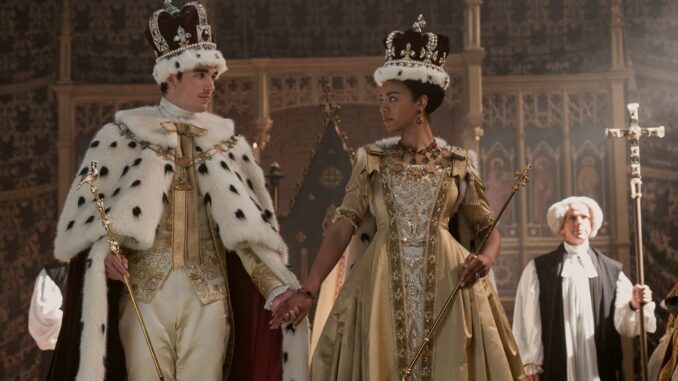
Bridgerton’s Queen Charlotte and its imitators have been praised for bringing diversity to the very white world of historical drama. But could these Black fantasies actually be dangerous?
Fantasy collided with reality last month, when the Black British actor Adjoa Andoh, who plays Bridgerton’s Lady Danbury, was invited by ITV to commentate on King Charles’s coronation. Andoh described the lineup of waving royals on the Buckingham Palace balcony as “terribly white”. With the family’s solitary person of color – the Duchess of Sussex – conspicuous by her absence, Andoh was technically correct. Even so, the comment prompted the highest number of complaints to Ofcom of any broadcast this year.
Perhaps Andoh had lost sight of the yawning gap between fiction and fact. Shows such as Netflix’s Bridgerton have been applauded for introducing actors of color into the “terribly white” space of costume drama, but some people remain resistant to anything that upsets their ideas of the past (even if those ideas were largely gleaned from costume dramas) .
We’ll come back to Bridgerton. In the meantime, another new show has had people up in arms: Queen Cleopatra, a Netflix docusseries co-produced and narrated by Jada Pinkett Smith. Its sin was to cast a Black actor as the Egyptian ruler: Britain’s Adele James, who is mixed race. Cleopatra has been portrayed many times by white actors, including Vivien Leigh, Elizabeth Taylor and Monica Bellucci, but this supposed “blackwashing” was too much for some – and not just the usual suspects. Egypt’s antiquities minister, Zahi Hawass, complaining: “This is completely fake. Cleopatra was Greek, meaning that she was light-skinned, not black.” One Egyptian lawyer even sought legal action to block Netflix in the country for its promotion of “Afrocentric thinking”.

Cleopatra’s precise pigmentation is up for debate: she was descended from the Greek-Macedonian Ptolemaic dynasty. But, the show’s makers argue, the dynasty may have intermarried with local Egyptians over the preceding 250 years, at a time when no one was classified as “black” or “white” anyway. “Why shouldn’t Cleopatra be a melanated sister?” asked Tina Gharavi, the show’s director. “And why do some people need Cleopatra to be white? Her proximity to whiteness seems to give her value, and for some Egyptians it seems to really matter.”
Queen Charlotte, the latest Bridgerton installation, hangs on a similar scrap of historical speculation: the theory that German-born Charlotte of Mecklenburg-Strelitz had African ancestry. Thus, young Charlotte is portrayed by British actor India Amarteifio, who has Ghanaian and German ancestry. “I know there are a lot of people who believe it’s absolutely fact that she’s from Black Portuguese royalty,” said the show’s creator, Shonda Rhimes. “The idea that would make her their first Black royal was very interesting to me.”
Queen Charlotte begins with the disclaimer that it is “fiction inspired by fact” and that “all liberties taken by the author are quite intentional”. There turn out to be quite a lot of freedom. This prequel chronicles Charlotte’s arranged marriage to George III in 1761, which blossoms into real love and ushers in a new era of racial unity in Britain – just like Harry and Meghan didn’t.
The Bridgerton extended universe has always taken a curious approach to race, but in Queen Charlotte it reaches bizarre levels. This parallel 18th-century Britain contains many wealthy Black people, such as the young Lady Danbury and her older, buffoonish, darker-skinned husband (who some have condemned as a racial caricature). These rich Black Britons went to Eton and Oxford, we’re told, but are excluded from white aristocratic society.
Charlotte and George’s union reminds what is dubbed “the great experiment” – bestowing upper-class titles and accepting upon these posh people of colour, and thereby bridging Britain’s racial divide. Racism is vanquished overnight, within the space of a formal dance to a string arrangement of an Alicia Keys track. “With one party,” George told Charlotte, “we have created more change, stepped forward more than Britain had in the last century.”
It wasn’t quite like that in the real world. There were between 10,000 and 20,000 Black people in Britain in the 18th century, but vanishingly few were wealthy. They were mainly men, mostly sailors, soldiers from the American revolutionary war – who were promised emancipation in return for fighting for the British – or servants working in the household of white people.
